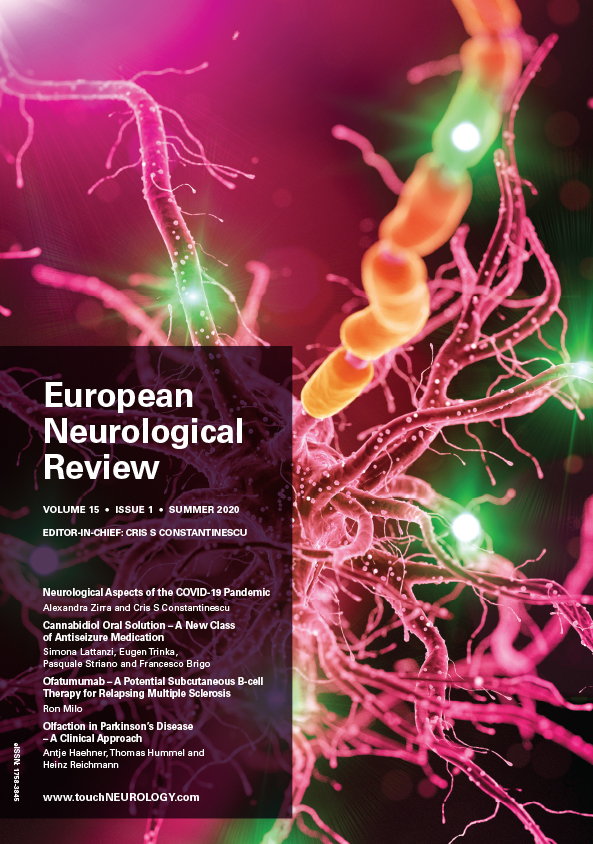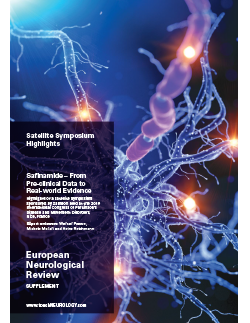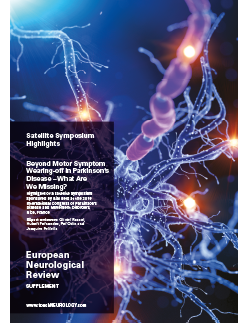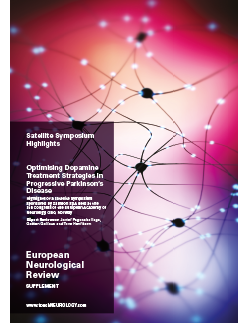EUROPEAN NEUROLOGICAL REVIEW – VOLUME 6 ISSUE 3 – AUTUMN 2011
The 15th Congress of the European Federation of the Neurological Societies (EFNS), held in Budapest, Hungary, from 10–13 September 2011 was again a great success with more than 5,000 participants and approximately 2,000 abstract submissions.
Neurodegenerative Disease
The continuous dopaminergic stimulation (CDS) concept dominates the current therapeutic management of Parkinson’s disease (PD), especially in moderate to advanced stages of the disease. The background is a combination of a number of findings, mainly that: • striatal dopaminergic stimulation is fairly constant in a healthy brain; • striatal dopaminergic stimulation in PD is pulsatile […]
Parkinson’s disease (PD) is the second most common neurodegenerative disorder and affects more than one in 100 people over the age of 65.1 The cardinal clinical features of PD are bradykinesia, resting tremor, rigidity and postural instability.2 The pathophysiological hallmark of PD is degeneration of the dopaminergic neurons of the substantia nigra leading to striatal […]
Brain Trauma
A tremendous amount of research effort has been put into the understanding and treatment of delayed cerebral vasospasm and its sequelae, namely the development of delayed ischaemic neurological deficits (DIND), since it contributes significantly to overall morbidity and mortality after subarachnoid haemorrhage (SAH), with death continuously occurring in excess of 25 % of patients.1
In the US, the incidence rate of new or recurrent stroke is approximately 795,000 per year, and stroke prevalence for individuals over the age of 20 years is estimated at seven million.1 Mortality rates in the first 30 days post-stroke have decreased owing to advances in emergency medicine and acute stroke care. There is also […]
Multiple Sclerosis
Multiple sclerosis (MS) is a chronic inflammatory and degenerative disorder of the central nervous system (CNS). Up to 10 % of adults with MS recall experiencing their first symptoms before 18 years of age, and between 2.5 and 5 % of MS patients are formally diagnosed during childhood or adolescence.1–7 The pathobiologic mechanisms underlying MS […]
Central Nervous System Disorders
Primary angiitis of the central nervous system (PACNS) fascinates by the multiplicity of its clinical manifestations, the complexity of its investigation, and the extensiveness of its differential diagnosis (see Table 1). Immunosuppressive therapy is central in the management of PACNS, but the optimal approach remains the subject of debate. Efforts are ongoing to identify subtypes […]
Surgery
All neurostimulation needs a source of power – now universally avbattery-powered system to power the implant and to allow patient mobility. As independence from a fixed power supply is essential, the generation, storage and supply of electricity has been one of the foremost limiting factors when it comes to developing new devices. Historically, electrical power […]
The vertebral artery (VA) is a branch of the subclavian artery, which runs along the cervical spine and ends intradurally at the junction with the basilar trunk. It is subdivided into four segments: V1 segment (ostial segment) from origin to C6, V2 segment (transversary segment) from C6 to C2, V3 segment (suboccipital segment) from C2 […]
Surgery for Traumatic Brain Injury
Cervical anterior discectomy (CAD) was introduced by Smith and Robinson, and Cloward, in 1958.1,2 They described the anterior approach to the cervical disc. After removal of the disc and herniated part an autograft taken from the iliac crest was introduced in the intervertebral space to promote fusion between the two adjacent vertebral bodies. The introduction […]
The treatment of intracranial aneurysms, both ruptured and unruptured, has witnessed a dramatic improvement in outcomes made possible by continuous refinement in microsurgical technique alongside major technological developments and a growing understanding of the physiology of the brain under normal circumstances or when challenged. Even after the advent of endovascular aneurysm treatment, exclusion of giant […]
Imaging
Gliomas are primitive cerebral tumours representing a heterogeneous group of intra-axial central nervous system neoplasms of glial origin with different histology, behaviour, molecular characteristics, natural history and thus prognosis.1–4 Four distinct tumour grades have been identified according to the degree of malignancy, as reported in the World Health Organization (WHO) classification.5 The low-grade gliomas (LGGs) […]
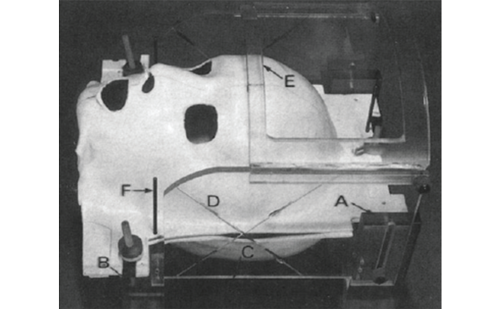
Trending Topic
Intracranial radiosurgery, no matter the means or methods of administration, is predicated on a core set of principles, including head immobilization and precise delineation of the treatment target. For some five decades after Leksell introduced the concept of stereotactic radiosurgery in 1951,1 rigid head fixation via an invasive device was an integral component towards these ends. […]
Journal Archive
European Neurological Review is a peer-reviewed, free-to-access, bi-annual neurology journal comprising review articles, case reports, practice guides, theoretical discussions, and original research. It features balanced and comprehensive articles written by leading authorities, addressing the most important and salient developments in the field of neurology in practical terms.
Latest articles videos and clinical updates - straight to your inbox
Log into your Touch Account
Earn and track your CME credits on the go, save articles for later, and follow the latest congress coverage.
Register now for FREE Access
Register for free to hear about the latest expert-led education, peer-reviewed articles, conference highlights, and innovative CME activities.
Sign up with an Email
Or use a Social Account.
This Functionality is for
Members Only
Explore the latest in medical education and stay current in your field. Create a free account to track your learning.




